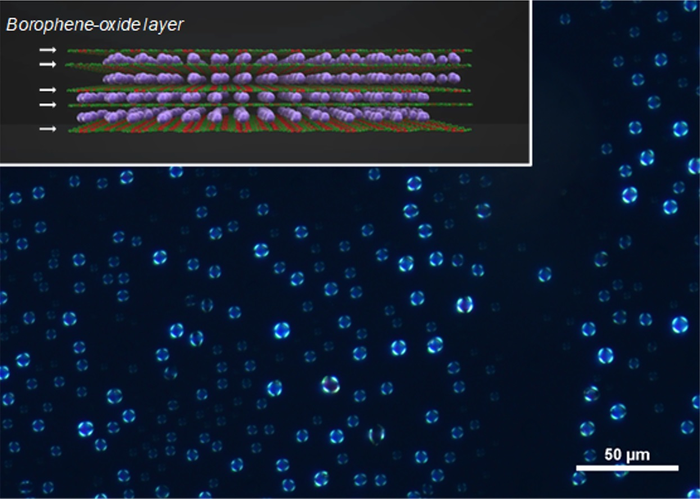Liquid crystals resulting from borophene have increased in popularity, due to their vast applicability in photonic and optoelectronic devices. However, their advance needs an extremely narrow temperature range, which obstructs their large-scale application.
 Visualization of the BoL-LC using polarized microscopy. The inset shows a chemical structure of the prepared BoLs. White arrows indicate the borophene oxide atomic layers and purple spheres represent potassium cations. Image Credit: Tokyo Institute of Technology.
Visualization of the BoL-LC using polarized microscopy. The inset shows a chemical structure of the prepared BoLs. White arrows indicate the borophene oxide atomic layers and purple spheres represent potassium cations. Image Credit: Tokyo Institute of Technology.
Currently, Tokyo Institute of Technology scientists explored a liquid-state borophene oxide, finding that it displayed high thermal strength and optical switching behavior even at low voltages. These findings highlight the robust potential of borophene oxide-derived liquid crystals for use in extensive applications.
Two-dimensional (2D) atomic layered materials, such as carbon-based graphene and boron-based borophene, are much sought after for their applications in a range of optoelectronic devices, owing to their advantageous electronic features.
The monolayer structure of borophene with a network of boron bonds bestows it with high versatility, which can be useful for the production of a liquid state at low temperatures. Thus, it is not unexpected that liquid crystals resulting from 2D networked structures are in great demand. However, the weak stability of borophene, specifically, renders it hard for it to endure a phase transition to the liquid state.
In contrast, borophene oxide — a derivative of borophene — can improve the steadiness of the internal boron network, in turn steadying the whole structure. This property of borophene oxide is diverse from that of other 2D materials, which are incapable of yielding liquid crystals without solvent usage.
To make up for the lack of appropriate liquid crystals, a team of scientists from Japan, including Assistant Professor Tetsuya Kambe and Professor Kimihisa Yamamoto from Tokyo Institute of Technology, examined the properties of a borophene oxide analog as a completely inorganic liquid with a layered structure. Their study has recently been published in the journal Nature Communications.
To begin with, the team used formerly tested techniques to produce borophene oxide layers (BoL) as crystals (BoL-C). They then changed BoL-C to liquid crystals (BoL-LC) by heating them to temperatures of 105–200 °C. They noticed that the subsequent dehydration weakened the interactions between the interlayers of BoL-C, which is necessary for its flexibility.
The researchers then examined the structural properties of BoL-LC using polarized optical microscopy, learning that BoL-LC sheets are found arranged parallel to the surface of the liquid drop with a marginally curved form. This spherulite orientation of borophene sheets was verified using scanning electron microscopy.
An examination of the phase transition properties showed that phase transition (P-ii/P-i) took place at about 100 °C for BoL-LC. In fact, both transition phases showed high thermal stability at extreme temperatures. The researchers also noticed an extremely ordered orientation of the P-ii phase.
To verify its optical switching performance, the team built a dynamic scattering device using BoL-LC and discovered that in contrast to other organic liquid crystals, the BoL-based device reacted well to voltages as low as 1 V. These findings underscore the viability of inorganic liquid devices in extreme environments.
Although a liquid crystal device using graphene oxide has been reported previously, it was a lyotropic liquid crystal, with a strong dependence on the solution concentration. Therefore, the previously reported material is different from the liquid borophene created in this study, without the use of any solvents.
Dr. Tetsuya Kambe, Assistant Professor, Tokyo Institute of Technology
Furthermore, they learned that even when exposed to direct fire, BoL-LC was noncombustible. This verifies that BoL-LC in a liquid state with an ordered layer structure can survive across a broad range of temperatures — a feature that has not been seen thus far for other organic materials.
When asked about the significance of these results, Dr. Kambe and Dr. Yamamoto stated, "BoL-LC exhibits strong potential for use in widespread applications, that are unavailable to conventional organic liquid crystals or inorganic materials."
Borophene liquid crystals are stacked with several benefits and may accelerate crucial developments in the optoelectronics and photonics sector in the future.
Journal Reference:
Kambe, T., et al. (2022) Liquid crystalline 2D borophene oxide for inorganic optical devices. Nature Communications. doi.org/10.1038/s41467-022-28625.